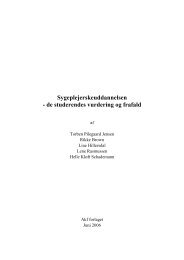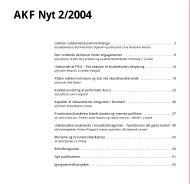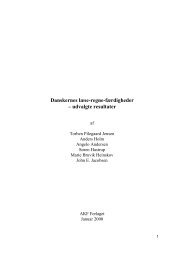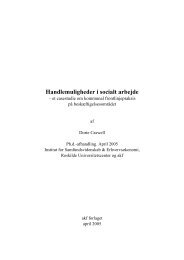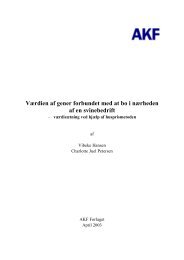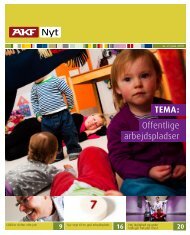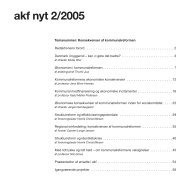Fremtidens ældre - Amternes og Kommunernes Forskningsinstitut
Fremtidens ældre - Amternes og Kommunernes Forskningsinstitut
Fremtidens ældre - Amternes og Kommunernes Forskningsinstitut
Create successful ePaper yourself
Turn your PDF publications into a flip-book with our unique Google optimized e-Paper software.
dem<strong>og</strong>raphic upheaval, and in part their relative state pensions are comparatively<br />
larger (e.g. compared to unemployment benefits).<br />
Basically, Denmark still has a high welfare standard (not for state pensions,<br />
but for pre-retirement benefits, etc. as well as for health and social<br />
care).<br />
This will result in an increase in public expenditure on the elderly of<br />
almost 6 per cent from 2000 to 2050, which is slightly more than the average<br />
of the other OECD countries referred to here (but significantly less<br />
than e.g. Finland and Norway).<br />
Although Denmark's expenditure on home care only makes up a small<br />
portion of public service expenditure on the elderly (15 per cent), a large<br />
proportion of elderly in Denmark receive publicly-funded home care. In<br />
addition, a relatively large number of Danish elderly people live in nursing<br />
homes (7 per cent), however this number does not differ essentially from<br />
what is seen in many other OECD countries. The idea of having the elderly<br />
live in their own homes as long as possible is far from being only a Danish<br />
phenomenon.<br />
Finally, the question is raised about whether there will be enough<br />
health and social care professionals in future. In Denmark today, there is<br />
already a shortage of doctors and nurses – so greater flexibility is needed<br />
among professionals taking medical and social care of the elderly.<br />
The final section of the report (Chapter 4) considers what can best be<br />
done to deal with the increasing numbers of elderly. Three areas are focused<br />
on:<br />
− General fiscal policy<br />
− Increased participation in the labour force<br />
− Changes in methods of financing the welfare society.<br />
With regard to general fiscal policy, it seems clear that increased public<br />
savings in coming years is one approach. This would provide greater economic<br />
flexibility for funding the care of the elderly.<br />
An increased participation in the workforce among Danes of all ages<br />
would provide opportunities for financing the needs of the elderly. This<br />
works both ways: more people would be paying taxes while fewer would<br />
be receiving transfer incomes. Most important, however, would be maintaining<br />
the present high employment rate (again, this is part of fiscal poli-<br />
69




